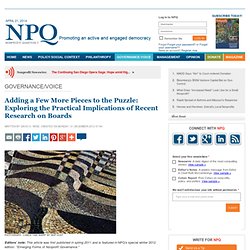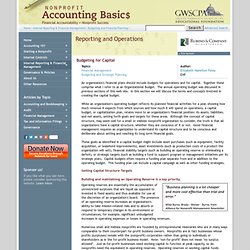

Why I Wrote the For-Impact Culture Code. Your Current Supporters Are Your Secret Weapon - Unleash Them! Nonprofits Need a Stronger Voice, but Not From the Wrong Messenger - Opinion. By Phil Buchanan Dan Pallotta’s Charity Case: How the Nonprofit Community Can Stand Up for Itself and Really Change the World argues forcefully that nonprofits need a stronger and more unified voice to speak up for their values.

In particular, Mr. Pallotta wants to fight the American obsession with using administrative spending rates as a way to gauge nonprofits and to combat the media’s tendency to raise questions about nonprofit CEO salaries that they deem excessive. (See “Charities Must Battle Misconceptions About Overhead Costs,” Opinion, September 20.) These are important, if not new, arguments. Shifting the emphasis away from this arbitrary and often ill-defined measure could lead to more resources flowing to the most effective nonprofits—and to more learning and improvement, with profoundly positive effects on the people and communities nonprofits seek to serve. But in Charity Case, the arguments are made by the wrong person in the wrong way.
The thing is, I am not sure Mr. Mr. Mr. Adding a Few More Pieces to the Puzzle: Exploring the Practical Implications of Recent Research on Boards. Editors’ note: This article was first published in spring 2011 and is featured in NPQ's special winter 2012 edition: "Emerging Forms of Nonprofit Governance.

" The challenge of leading nonprofit organizations in today’s tumultuous and complex environment encourages both nonprofit leaders and researchers to pay more attention to studying nonprofit boards and what enables them to be strong and effective. Perhaps more than ever, nonprofit organizations and their leaders are dedicated to developing highly effective ways to govern and lead, and to enhance their performance, competitiveness, and strategic advantage.
Unfortunately, even as we develop increasingly important insights into the changing nature of boards and their work, far too many in the sector continue to base their understanding of board work on anecdote, conventional wisdom, and stories from the past. Of course, in these challenging times this shouldn’t be too surprising. Understanding Variation in the World of Boards Notes. How to Engage Your Board Members - and Keep Them That Way. Untitled. Nonprofit - Performance articles from McKinsey Quarterly. What Nonaccountants Should Know About Nonprofit Financial Statements. Details Written by Dugan Lopatka Without some assistance, nonaccountants may find it difficult to fully understand financial statements.

But your nonprofit organization may benefit if you and other key personnel learn the fundamentals of financial statements. Here’s a primer to help you interpret the numbers. Every nonprofit organization’s financial statements produced for external use should include four parts: A balance sheet (sometimes called a statement of financial position),An activities statement (sometimes called support, revenue, expenses and changes in net assets),A cash flow statement, andExplanatory footnotes. Voluntary health and welfare organizations should also include a statement of functional expenses. The Balance Sheet The balance sheet is a snapshot of your financial situation at a moment in time, such as at your year end. The balance sheet lists assets and liabilities in order of liquidity.
The Activities Statement The Cash Flow Statement Equipment depreciation, Timeliness. Collaboration Software and Online Project Management for Businesses - Central Desktop. Nonprofit Accounting Basics. An organization's financial plans should include budgets for operations and for capital.

Together these comprise what I refer to as an Organizational Budget. The annual operating budget was discussed in previous sections of this web site. In this section we will discuss the terms and concepts involved in creating the capital budget. While an organization's operating budget reflects its planned financial activities for a year, showing how much revenue it expects from which sources and how much it will spend on operations, a capital budget, or capitalization plan, relates more to an organization's financial position: its assets, liabilities, and net assets, setting forth goals and targets for these areas.
Although the concept of capital structure, may seem odd for a small or midsize nonprofit organization to consider, the truth is that all organizations have a capital structure, whether they are conscious of it or not. Setting Capital Structure Targets Deficit Reduction is a top priority. How to Use Google Calendar as a Project Management Tool.
Employment. Three Questions Your Board Members Really Need to Know. Using Your Strategic Plan.